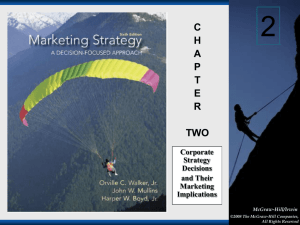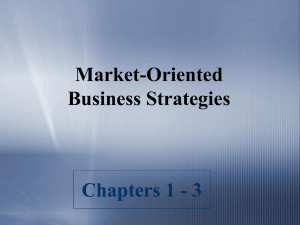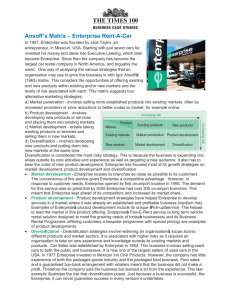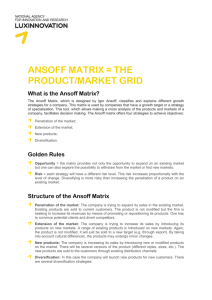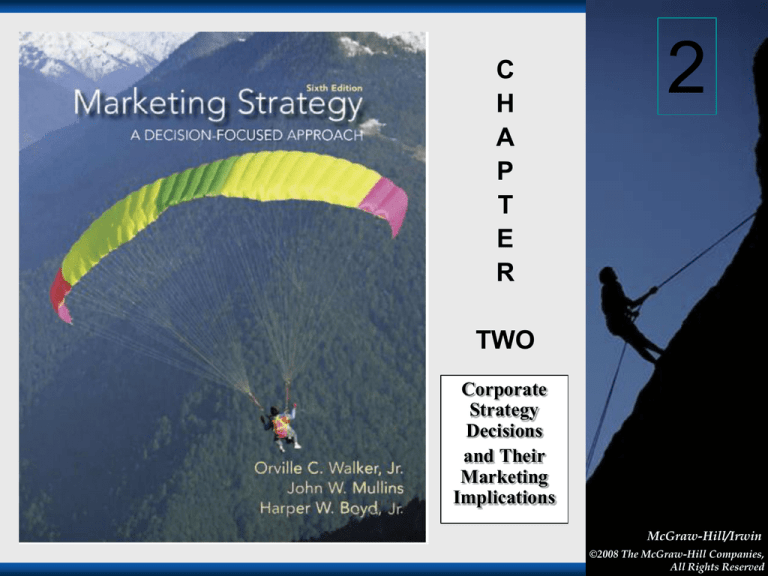
C
H
A
P
T
E
R
2
TWO
Corporate
Strategy
Decisions
and Their
Marketing
Implications
McGraw-Hill/Irwin
©2008 The McGraw-Hill Companies,
1-1
All Rights Reserved
Ryanair
1991 pre low cost ad
Low cost no frills
Own planes Boeing 737s
Fast turn around 25 minutes on ground
Under utilized Regional airports
Lower fees, Best on time
Carry and stow own bags, no in-flight
services
Flight attendants pay for own training
and uniform
1-2 2-2
More Ryanair
Pays no fees to computer reservations
systems and no commissions
Competition from Major airlines
Easyjet
Marketing costs same per passengerkilometer
Too much growth?
Documentary
1-3 2-3
Scope, mission and intent
What business(es) should the firm be
in?
What customer needs, market segments,
and/or technologies should be focused
on”?
What is the firm’s enduring strategic
purpose or intent?
1-4 2-4
Discussion Questions
1. In defining their strategies,
should companies pursue
broadly or narrowly defined
missions?
2. What are the advantages of
each approach?
Marketing Myopia
Fit or Future
1-5 2-5
Exhibit 2.2
Characteristics of Effective
Corporate Mission Statements
Functional
Based on
customer needs
Broad
Specific
Transportation
business
Long-distance
transportation for largevolume producers of
low-value, low-density
products
Physical
Railroad
Based on existing business
products or
technology
Long-haul, coal
carrying railroad
Source: Adapted from Strategy Formulation: Analytical
Concepts, by C. W. Hofer and D. Schendel. Copyright ©
by West Publishing Company. All rights reserved.
1-6 2-6
Sustainable?
3% currently do a good job
2/3rds have code of ethics
Chevron
To bribe or not to bribe
1-7 2-7
1-8 2-8
Objectives
What performance dimensions should
the firm’s business units and employees
focus on?
What is the target level of performance
to be achieved on each dimension?
What is the time frame in which each
target should be attained?
1-9 2-9
Discussion Question
3. What are some common
performance dimensions and
measures used to specify
corporate objectives?
1-102-10
Specific
Measurable
Attainable
Relevant
Time-bound
Multiple objectives/Trade offs
1-112-11
1-122-12
Discussion Question
4. What kind of company resources
provide the foundation for
effective competitive and
marketing strategies?
What human, technical, or other
resources or competencies
available to the firm provide a
basis for a sustainable competitive
advantage?
1-132-13
Samsung
Korean
R&D
Marketing to improve brand
Changed Channel emphasis
1-142-14
Development Strategy
How Can the firm achieve a desired
level of growth over time?
Can the desire growth be attained by
expanding the firm’s current business?
Will the company have to diversify into
new businesses or product-markets to
achieve its future growth objectives?
1-152-15
Discussion Question
5. Ansoff says there are four
strategies for growing a
business. What are their merits
and drawbacks?.
1-162-16
Ansoff: Corporate Growth
Strategies
Current Markets
Current Products
Market penetration
strategy
New Products
Product development
strategy
New Markets
Market development
strategy
Diversification
strategy
1-172-17
Exhibit 2.5
Alternative Corporate Growth
Strategies
New
markets
Current
markets
Current products
New products
Market penetration strategies Product development
• Increase market share
strategies
• Increase product usage
Increase frequency of use
Increase quantity used
New applications
• Product improvements
• Product-line extensions
• New products for same
market
Market development
strategies
Diversification strategies
• Expand markets for existing
products
Geographic expansion
Target new segments
• Vertical integration
Forward/backward integration
• Diversification into related bus
(concentric diversification)
• Diversification into unrelated
businesses (conglomerate
diversification)
1-182-18
Resource allocation
How should the firm’s limited financial
resources be allocated across its
businesses to produce the highest
returns?
Of the alternative strategies that each
business might pursue, which will
produce the greatest returns for the
dollars invested?
1-192-19
Discussion Question
6. What models can we use at the
corporate level to help in
resource allocation decisions?
1-202-20
Resource Allocation: The
BCG Growth Share
Matrix
(Exhibit: 2.6.)
High
Stars
Question marks
5
4
6
Market
growth
10%
rate
Cash cows
7
(in
constant
dollars)
9
Low
10
2
1
11
Dogs
12
3
8
10
13
1
Relative market share
0.1
Source: Adapted from Barry Hedley, “Strategy and the Business Portfolio,” Long Range Planning 10 (February 1977).
1-212-21
Cash Flows Across Businesses
in BCG Portfolio Model
Growth rate (cash use)
(Exhibit 2.7.)
High
Question
marks
Stars
Cash
Flows
Low
Cash cows
High
Dogs
Relative market share
Low
Desired direction of business development
1-222-22
Resource Allocation: The GE
Nine-Cell Matrix
Business’s
competitive position
(Exhibit: 2.8.)
Industry attractiveness
High
Medium
Low
High
1
1
2
Medium
1
2
3
Low
2
3
3
1 Invest/grow
2 Selective investment/ maintain position
3 Harvest/divest
1-232-23
Factors Affecting the Creation of
Shareholder Value
(Exhibit: 2.9.)
Corporate
objective
Creating
shareholder
value
Valuation
components
Cash flow
from
operations
Discount
rate
Sales growth
• Operating
profit margin
• Income tax
rate
• Working
capital
investment
• Fixed capital
investment
Operating
Investment
• Value
Value growth
drivers duration
Management
decisions
Shareholder return
• Dividends
• Capital gains
Debt
• Cost of
capital
Financing
Source: Reprinted with permission of The Free Press, A Division of Macmillan, Inc., from Crating Shareholder Value by Alfred Rappaport.
Copyright © 1986 by Alfred Rappaport.
1-242-24
Sources of Synergy
What competencies, knowledge, and
customer-based intangibles (e.g., brand
recognition, reputation) might be
developed and shared across the firm’s
businesses?
What operation resources, facilities, or
functions (e.g., plants, R&D, salesforce)
might the firm’s business share to
increase their efficiency?
1-252-25
Discussion Question
7. Where do potential synergies
lie at the corporate level?
1-262-26
Knowledge-based Synergies
Learning organization
Centralized R&D
Corporate Identity and the Corporate
Brand
Disney/The Body Shop/Caterpillar
One brand name for all Cisco Systems, Siemens,
IBM
Dual Branding
Individual Branding
Synergy from shared resources
Sharing operational resources across
business units
Single plant
Single sales force
1-272-27

